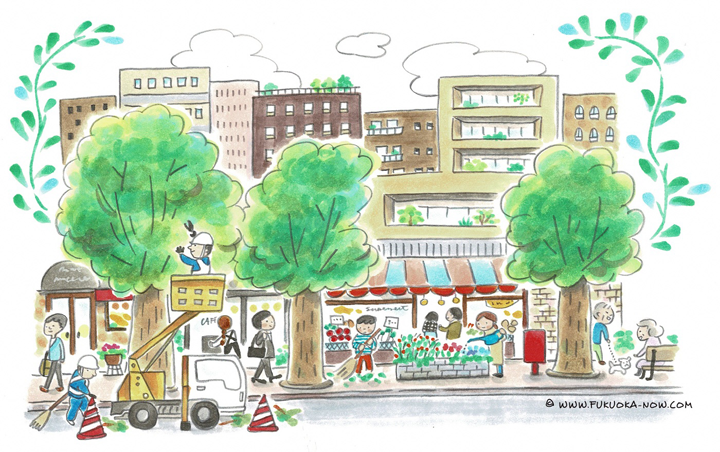Hakata Culture vol.171
A Great Time to Enjoy Fukuoka’s Roadside Trees

Spring has sprung, and this is a great time of year to take a stroll in the shade of Fukuoka’s tree-lined streets. Technically, the trees planted along public roads are considered “road appendages” installed by the road administrator authority. For this reason, as with traffic signals and guard rails, they help to keep public roads safe.
Naturally, roadside trees maintain safety by creating a barrier between pedestrians and vehicles, but they perform many other functions as well. Trees reduce road noise and dust, absorb emissions, and provide shade on hot days. They also play a role in conserving the natural environment by providing homes for birds and insects. What’s more, in the event of a fire, roadside trees have been shown to slow the spread of flames.
The main types of roadside trees in the city are zelkova, cherry, ginkgo, woodland elaeocarpus, Kurogane holly and camphor. In addition to the 50,000 large trees planted along the city’s streets, there are also low-lying shrubs like azalea, so the Fukuoka is truly full of vegetation. Because they are living things, naturally, these roadside trees and shrubs need tender loving care. This is why experts conduct daily patrols to check on the trees and shrubs and take action when necessary.
The general public can also get involved in maintaining public roadside trees. One way to do this is through cleanup efforts, which are especially necessary in the fall and winter when deciduous trees lose their leaves. Fukuoka City also runs the “One Citizen One Flower” flower bed initiative that seeks to beautify the city by getting the citizens involved in planting and caring for flowers and greenery. There are also volunteer groups that receive subsidies from City Hall to plant flowers along pedestrian paths and other designated zones.
さわやかな季節の福岡の街路樹
新緑の季節がやってきました。この時期になると、あちこちで緑鮮やかな街路樹が目立つようになり、木陰をつくる並木道の下を歩くのも楽しくなります。実は、こうした公共の道路に植えられている街路樹は、道路管理者が設置する「道路の附属物」と位置づけられています。そのため法律上では信号機やガードレールと同じ扱いで、道路の安全性を守るものの一つとされているのです。
街路樹は歩行者と車を分離することで安全性を高めるだけでなく、他にもさまざまな機能を持っています。道路からの騒音や粉塵を減らしたり、排気ガスなどを吸収するほか、暑い日には日差しを遮ってくれます。また鳥や虫の住みかになり、街並の景観を向上させるなど、自然環境や生活環境を守る役割も果たしています。さらに火災のときには延焼を防いでくれることが分かっています。
福岡の代表的な街路樹はケヤキ、サクラ、イチョウ、ホルトノキ、クロガネモチ、クスノキなどです。高木だけで約50,000本が植わっていて、これにツツジなどの低木類を加えて、市内の至る所に植栽されています。街路樹は当然ながら生きているので、適切な健康管理が必要です。そのために専門家が日々パトロールをして、街路樹の生育状況をチェックしたり、必要な処置を行います。
一般市民でも、公共の街路樹の維持に参加できることがあります。ひとつは街路の清掃。とりわけ落葉の季節には地域の人が協力して清掃する必要があります。また福岡市では「一人一花運動」といって、みんなが花や緑を育てることで街中を花いっぱいにしようという運動を行っています。歩道の植栽帯などでボランティアで花づくりをする活動もあり、申請により助成金も交付しています。

